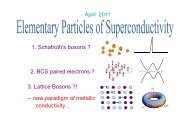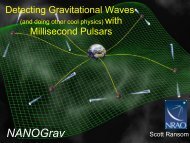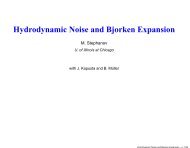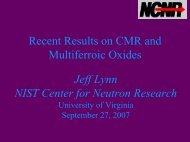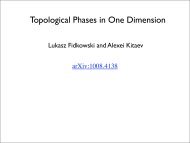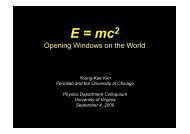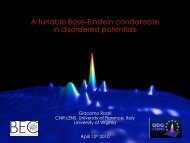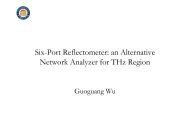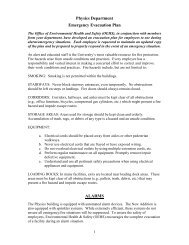Fractional topological insulators
Fractional topological insulators
Fractional topological insulators
Create successful ePaper yourself
Turn your PDF publications into a flip-book with our unique Google optimized e-Paper software.
%<br />
!"<br />
!<br />
Perspective - bulk vs. edge<br />
$./<br />
'()*+,<br />
-()*+,<br />
$ %$ &$<br />
$<br />
$ % & ' !"#<br />
#"<br />
2"<br />
$"#<br />
$.&<br />
$.%<br />
!"#()($01!"#"$<br />
,"<br />
!"#()($01!"#"% !"#()('01!"#"%<br />
$<br />
fractionalized excitations in the bulk!<br />
Bulk $ rich '...% &' $ '<br />
&<br />
edge poor % &' $ '<br />
&<br />
% &'<br />
&<br />
Thursday, March 22, 2012<br />
No propagating edge modes, but...<br />
FIG. 1. (color online). Numerical exact diagonalization results<br />
of Hamiltonian (2.1) for 16 electrons when sublattice A<br />
is made of 3 × 4sitesandwitht 2 /t 1 =0.4. (a) Ground state<br />
degeneracies. Denote with E n the n-th lowest energy eigenvalue<br />
of the many-body spectrum where E 1 is the many-body<br />
ground state, i.e., E n+1 ≥ E n for n =1, 2, ···. Define the parameter<br />
by n := (E n+1 − E n )/(E n − E 1 ). If a large gap<br />
&<br />
lattice momentum k and spin σ =↑, ↓ in t<br />
α = A, B and combine them in the subl<br />
ψ † k,σ<br />
c := † k,A,σ ,c† k,B,σ<br />
. Then, the secon<br />
single-particle Hamiltonian reads<br />
H 0 := <br />
B k · τ<br />
|B k<br />
| ψ k,↑ + ψ † B −k ·<br />
<br />
k,↓ B −<br />
ψ † k,↑<br />
k∈BZ<br />
Edge modes?<br />
where the 3-vector B k<br />
is defined by<br />
M. Levin and A. Stern, PRL (2009)<br />
B 0,k := 0,<br />
T. Neupert et al. PRB (2011)<br />
B 1,k +iB 2,k := t 1 e −iπ/4 1+e +i (k y −<br />
+ t 1 e +iπ/4 e −ik x + e<br />
B 3,k := 2t 2<br />
<br />
cos kx − cos k y<br />
<br />
,<br />
and the three Pauli-matrices τ =(τ 1 , τ 2 , τ 3<br />
sublattice index. Here, t 1 and t 2 represent<br />
neighbor (NN) and next-nearest neighbor<br />
ping amplitudes. The Hamiltonian (2.2a)<br />
defined if t 2 = 0.<br />
One verifies that H 0 is both time-reversa<br />
and invariant under U(1) spin-1/2 rotations<br />
time-reversal operation T acts on numbers<br />
conjugation and on the electron-operators a<br />
ψ † k,↑<br />
T<br />
−→ +ψ † −k,↓ ,<br />
ψ† k,↓<br />
T<br />
−→ −ψ † −k<br />
The action of the U(1) spin-1/2 rotation R γ<br />
0 ≤ γ < 2π is given by<br />
ψ † k,↑<br />
NO<br />
R γ<br />
−→ e +iγ ψ † k,↑ ,<br />
ψ† k,↓<br />
R γ<br />
−→ e −iγ ψ † k



